Horrific Inquiry: NIGHT OF THE LIVING DEAD (1968)
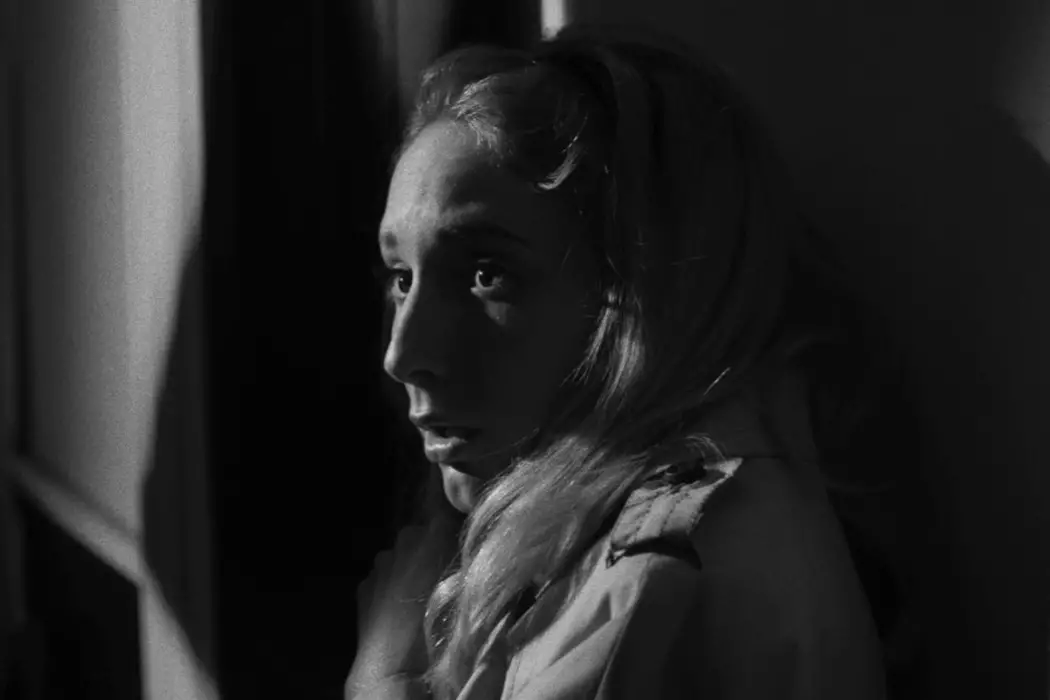
Stephanie Archer is 39 year old film fanatic living in…
Welcome back to the newest, and at times goriest, column here at Film Inquiry: Horrific Inquiry. Twice a month, I will be tackling all things horror, bringing two films back into the spotlight to terrify and frighten once more. And occasionally looking at those that could have pushed the envelope further. Join us as we dive deep into the heart of horror, but warning, there will be spoilers.
Let the Halloween countdown continue!
We all have those films we are embarrassed to admit we have never seen. These films are staples of not only their genre but within the history of cinema itself. As a self-proclaimed horror buff, I find myself having to admit that I have never seen George A. Romero’s Night of the Living Dead. While over the years I have watched my fair share of zombie flicks, it was this critically acclaimed masterpiece that until now has continued to allude me.
As we enter into the second week of October, inching that much closer to Halloween, it seemed like not only the perfect time but the perfect film for the occasion.
“They’re coming to get you, Barbara.”
In all honesty, I was genuinely unsure what to expect from Night of the Living Dead. While a name synonymous with not only zombies but the genre of horror itself, there was little that came to mind when thinking of the film. I was surprised, when I really thought about it, how little the film had come up over the years – even in popular pop culture reference. That is until the film’s opening scene…
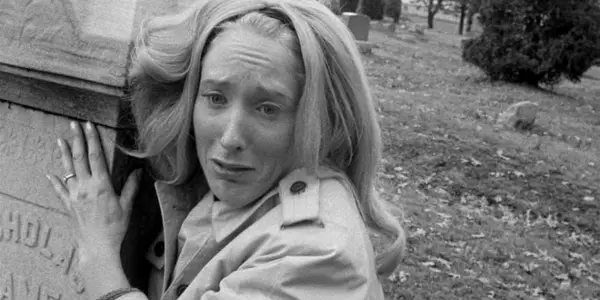
As Night of the Living Dead begins, audiences are presented with a winding road, a car in the distance slowly drawing closer to the camera. As the opening credits cycle through, the car is recaptured at various points along this winding road, the black and white filming removing any colors or distractions from the viewer. Knowing what the occupants are sure to encounter at some point in the film, the road starts to resonate a feeling of the yellow brick road, their trip weaving further and further from the reality they have known to the unexpected and the unexplained.
As the car turns into the local cemetery, audiences finally met the car’s occupants, brother and sister Johnny (Russell Streiner) and Barbara (Judith O’Dea). While Barbara is reserved, Johnny is strongly opinionated and clearly unconvinced. As he picks up a cross wreath from the backseat, he laments on the ridiculous nature of traveling as far as they have just for the sake of remembering their later father — mostly for the solace of their mother. As he continues to negate the practice, as well as his sister’s prayers, he begins to tease and further terrify Barbara. Her fears are only further heightened as the man Johnny has singled out to “come for her”, lunges out, attacking Barbara. As Johnny’s attempts to save her ends in his untimely death, Barbara runs for her life.
Night of the Living Dead succeeds immediately in its creation of the film’s tension. While the tussle between man and zombie, and Barbara’s random clinging of objects, has not exactly lived up to the test of time, the intensity of the chase is maintained through the film’s score. And what a score it is. It is dramatic, loud, ominous, and screaming for Barbara to run. The opening in its entirety is rather long, but the score keeps the characters moving and the attention of the audience.
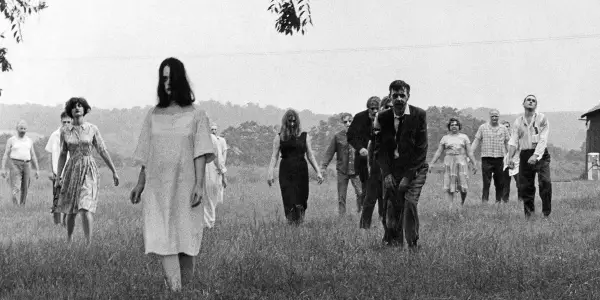
As will carry through for mostly the first half of the film, dialogue is very limited, even after Barbara is joined in the house by Ben (Duane Jones). Running from his own monsters, they both find refuge within the old farmhouse. As Barbara begins to shut down due to the shock fo her ordeal, Ben launches into action, boarding up all the doors and windows throughout the home. As the terror of the ghouls outside instills lasting fear, it is the leftover remains of a previous victim that truly repels them, its inclusion in the film for gory effect, but also the spike of divide further driving the opposing reactions of both Barbara and Ben. While they are both repulsed, Ben is able to pull himself together and push through, whereas Barbara recoils both physically and mentally.
“Kill the brain, you kill the ghoul”
The zombies in Night of the Living Dead are smarter than you think they would be. Using tools throughout the film, moving in an almost Frankenstein movement, they break car and home windows with rocks, even beginning to pick up pieces of wood to try and beat their way into the home. As much as in a trance as they seem, there is an almost animalistic need for survival that pulsates through their human brains.
What I was genuinely surprised the most by was how deeply ingrained the ideas of zombies have been over the decades since the release of Night of the Living Dead. As the TV and radio fill in the information for both the characters and the audience, we are informed the best way to kill zombies is by destroying the brain – “kill the brain you kill the ghoul”. Furthermore, they consume the flesh of those they attack, their bodies the arisen dead. These are staples within the horror genre, that while modified, have been a lasting doctrine throughout the sub-genre.
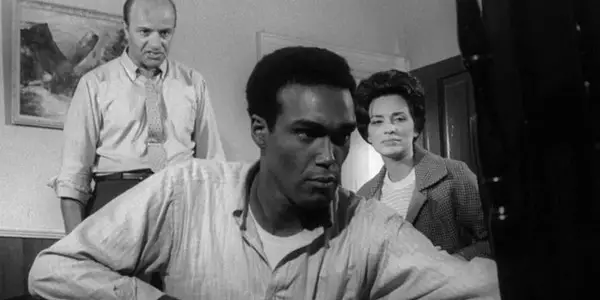
What I truly didn’t expect to hear was the cause for the rise of the ghouls. Oftentimes explained as a result of a virus (usually an outbreak starting outside of Atlanta, GA where the CDC headquarters resides, with usually no sign of patient zero), here the filmmakers have leaned into the direction of radiation exposure due to a destroyed satellite returning from Venus. As the remnants have fallen over the Pennsylvania countryside, it has permeated the dead, manipulating the mind and returning those who have died within minutes. In a world following the dropping of the atomic bombs and the use of nuclear fusion energy on the rise, the dangers of radiation exposure loomed, the lack of understanding of its effects terrifying.
It is not only the legacy that Night of the Living Dead leaves that makes it a classic but also its examination of the instant removal of humanity. Zombies, once arisen, are no longer seen as human, constantly referred to as “it”. While they look the same as the humans they prey on, in an instant, they are no longer viewed as humans, but rather monsters. While much of the removal speaks to the need for survival, it speaks to the repulsion towards those within our species that are different — physically or behaviorally. They are no longer one of us, needing to be taken out — at all costs as the film’s ending horrifically reveals.
Not all monsters are on the other side of the door
Night of the Living Dead not only looks at humanity through its instant treatment of zombies but also through its survivors. As mentioned earlier, Barbara and Ben each react differently to the ghouls and the dead. While one is pushed forward to do all that he can to survive, the other closes in on herself, unable to move or to think. While we are given the expected treatment of women through their reserved nature and little dialogue, albeit a fist exchange between Barbara and Ben, Ben, Harry (Karl Hardman), and Tom (Keith Wayne) each encompass a different version of humanity.
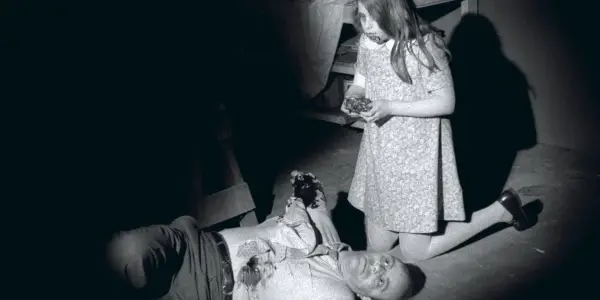
While they each experience fear, they each react differently. Ben pushes forward as we now know, but his need for survival extends beyond himself, taking those around him under his protection. He is “the brave”. He is contrasted by Harry, “the coward”. His fear consumes him, pushing irrational decisions. He compounds his fear further as he is pushed by the others to be braver, to help in the fight and survival of the others. He is eccentric in his worldview, thinking only of his survival. He is his only champion and savior, angered by those who would challenge his view. While he does push past his fear at times, he always recoils back into it – many times to the detriment of others.
Tom becomes the film’s “middle man”. While he is concerned with his wellbeing, and that of his partner Judy (Judith Ridley), his empathy encompasses all of those around him. There is a nativity in his eyes, yet longing to be useful. He is afraid but is unwilling to stand idly aside as others struggle to survive. He is unafraid to speak up, even when it is on the coattails of more vocal men. Tom’s outcome can go either way and in a metaphorical battle between strength and superiority, he is the group’s first victim.
Black and White Beyond the Celluloid
As Barbara and Ben interacted throughout the house, Barbara limps in her aid of Ben’s strive to save and protect them. I couldn’t help see the societal division melt away between them. In honesty, they never initially existed on celluloid. Regardless of skin color or gender, Barbara and Ben worked together beyond their presumed differences. There was no fear or superiority exhibited between them, bordering more along the lines of empathy and comfort in the face of disaster.
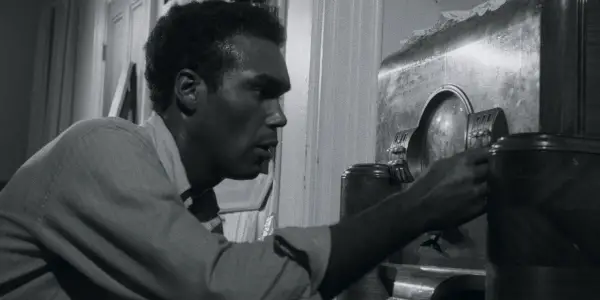
This is severally contrasted by Ben and Harry in the film’s second half. As Harry emerges from the basement where he has been hiding, he sees himself as the group’s superior. While he presents no reasons or advanced knowledge for his logic that the basement will be safer than the house, he adamantly expresses that he is right and everyone should follow him. Ben, on the other hand, feeling as the house will be safer – and having done the work to make it so – holds tight of his position, emulating knowledge and experience, rather than an instant sense of superiority. And as Harry continually expresses his cowardice, exclaiming no one will be allowed in the basement once he closes it or that he is taking supplies with him, he only proves himself more the coward than the leader he believes himself to be.
Conclusion: Night of the Living Dead
By the film’s conclusion, there is a sense that survival is a constant battle — not just with the zombies. As the ghouls descend on the home, breaking through in a chaotic and violent display, Ben finds solace in the basement, his fate left unknown as dawn is seen rising outside the farmhouse. As promised, a team of marksmen are making their way through the fields, taking out ghouls they see with their long-range rifles. Noting the house beyond the tree line, they set off to search the home for survivors. As they approach the house, Ben emerges from the basement. While he raises his gun for protection until he can identify the approaching group, the group does not hesitate, seeing only a dehumanized creature that needs to be taken out.
As they approach the corpse of Ben, there is little regard for the civilian they have just taken out, only a call for a fire to ensure he stays dead. As the film closes on his burning corpse, there is a sense that the film too is questioning who the real ghouls in the film are – and if survival was ever a choice or a possibility.
What are your thoughts on Night of the Living Dead? Let us know in the comments below!
Join us next week as we continue the horrific Halloween!
Does content like this matter to you?
Become a Member and support film journalism. Unlock access to all of Film Inquiry`s great articles. Join a community of like-minded readers who are passionate about cinema - get access to our private members Network, give back to independent filmmakers, and more.













